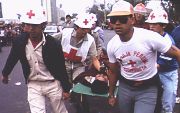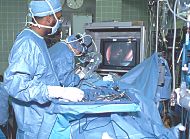Designing With Disaster in Mind
By Vanessa Rosales Ardón
 A hospital collapses during an earthquake, trapping hundreds of patients, hospital staff, and visitors. Many of those lucky enough to survive are injured. Elsewhere, another hospital loses its roof during a hurricane. Suddenly, the winds carry away everything that is not nailed down. Outside, the injured stumble through the rubble to the nearest health center, unaware that there will be few people to care for them, and equipment not damaged will most likely be useless without electricity.
A hospital collapses during an earthquake, trapping hundreds of patients, hospital staff, and visitors. Many of those lucky enough to survive are injured. Elsewhere, another hospital loses its roof during a hurricane. Suddenly, the winds carry away everything that is not nailed down. Outside, the injured stumble through the rubble to the nearest health center, unaware that there will be few people to care for them, and equipment not damaged will most likely be useless without electricity.
Far from fiction, these things happen time and again. In 1985, one of the world's largest metropolitan centers--Mexico City--was hit by a severe earthquake, putting a recently created emergency plan to an exacting test. Preparedness alone was not enough: the collapse of one wing of the Hospital Juárez claimed 561 lives, including those of doctors and nurses who were among the country's best trained to respond to mass injuries in an emergency.
In many ways, the Mexico City earthquake served as a wake-up call: how can hospitals, viewed by the public as protectors of life, be made safe from disaster, thus enabling them to function when their valuable personnel and services are most critically needed?
 Jamaica learned valuable lessons following 1988's Hurricane Gilbert. Many Jamaicans were too young to remember Charlie in 1951, the country's last hurricane experience, and did not heed early preparation warnings. During Gilbert's eight-hour rampage across the island, it damaged 95% of all health facilities, including Princess Margaret Hospital, above, which lost its roof in minutes. |
"Damage to buildings by hurricanes in the Caribbean is almost completely preventable. The most common damage is to roofs, external doors, and windows. Granted, it may be difficult to retrofit old structures, because building maintenance budgets for the public sector are always easy targets for cost reductions. But the so-called nonstructural elements are relatively simple and inexpensive to retrofit. Hurricane straps, for example, keep roofs on. Windows can be made safe from flying objects by reliable shutters with strong bolts and hinges. Toppling bookshelves, internal partitions, medicine cabinets, generators, computers--all of these could be made secure at a very moderate cost, even in the case of earthquakes," says Gibbs.
Yet structural safety is only one part of the picture in disaster preparedness in hospitals. Equally important is the way people--not just trained hospital staff, but the public at large--respond in a disaster situation. The appropriate knowledge and swift, calm, and concerted action will not prevent disasters from happening, but they enable communities to wield surprising control over disasters' worst effects.
When the U.N. General Assembly declared the 1990s the International Decade for Natural Disaster Reduction (IDNDR), it was an acknowledgement that the issues are complex. Yet some things are clear. Over the last 20 years, natural disasters have killed more than 3 million people worldwide, injured more than 800 million, and caused damages in the hundreds of billions of dollars. Furthermore, gross national product lost due to natural disasters is estimated to be 20 times greater in developing countries than in developed countries.
Emergency management experts are only now becoming aware that disasters are often unsolved development problems: progress in social development will be eroded if national governments do not take natural disasters into account in their development planning. "Disasters in developing countries are an integral part of their poverty cycle," states the 1994 Human Development Report published by the United Nations Development Program. "Poverty causes disasters. And disasters exacerbate poverty."
 Relatively simple and cost-effective, emergency simulation drills such as the one above in Peru teach community readiness. Hospitals and their trained staffs can take a lead in disaster response by training search and rescue teams, first-aid workers, fire fighters, police and security forces to work together effectively. |
Latin American and Caribbean natural disasters have grabbed their fair share of newspaper headlines. Earthquake in Peru, 67,000 dead in 1970. Earthquake in Nicaragua, 5,000 dead in 1972, and in Guatemala, 23,000 dead in 1976. Mexico City's 1985 earthquake, 10,000 dead.
In many ways, the Mexican story crystallized human tragedy and left an image in the public's mind. Likewise, each year as hurricane season approaches, it churns up memories of tragedy in tropical settings. Hurricanes David (1979), Gilbert (1988), Hugo (1989), and Luis (1995) all but wiped out major hospitals in Dominica, Jamaica, Monserrat, and Antigua and St. Kitts, respectively, leaving more than 800,000 people without access to needed emergency health care.
Clearly, in the years to come, the vulnerability of Latin America and the Caribbean to natural disasters is an issue that must be resolved. "This vulnerability is particularly troubling," notes a 1994 Pan American Health Organization report, "considering that rapidly industrializing countries like Mexico and Brazil have made significant capital investments in highly vulnerable areas, and that the Caribbean tourism industry, one of the most developed and modern in the world, is at the mercy of hurricanes each year. This level of development achieved over the years . . . must be protected from natural disasters."
Soon after their adoption, the goals of the U.N. Decade started becoming actions enlisting the support from a wide range of groups in society, ranging from children to governments. A case in point occurred in Mexico when a group of experts under the auspices of PAHO's Emergency Prepared-ness and Disaster Relief Program met over the occasion of the U.N.'s International Day for Disaster Reduction in 1993.
The group adopted the slogan, "Stop Disasters: Focus on Schools and Hospitals," and aimed educational efforts at teachers, health workers, and children--those who work in the schools and hospitals and those whom they serve. With this as a starting point, the group then broadened its campaign for building safety to reach national planners and policymakers, engineers, architects, and construction supervisors.
This effort to convince society of the need to ensure new buildings are safe, and to repair and maintain existing structures to make them safe, is at the core of the U.N. Decade. The program spearheaded by PAHO and supported by the Canadian and United States Governments became a "demonstration project."
 Hospitals, because they are densely populated around the clock, contain sick and immobile patients, and house dangerous chemicals, are especially vulnerable during disasters. Structural damage to Mexico City's Hospital General, below, during the 1985 quake took a vital resource out of commission and brought death to 295 victims trapped inside. |
The issue of hospital vulnerability is not one every country is eager to address. In many, health regulatory agencies argue they have higher priorities that are more emergency-oriented or more highly visible, such as fighting disease, mass vaccination programs, equipping hospitals with state-of-the-art technology, or health care reform. The relatively novel concept of disaster mitigation in hospitals only took root as the developing countries, in particular, began to realize the crucial role health facilities play in the aftermath of a natural disaster in protecting the lives and well-being of their populations.
By 1993, various hospital authorities in Costa Rica, Mexico, Saint Lucia, Dominica, and Colombia had completed studies of their buildings' vulnerability and several of the structures had either been reinforced for improved disaster resistance or were in the process of having that done. In Mexico, while health facilities damaged in 1985 were being reconstructed, a National Civil Defense System was created to educate citizens and communities about what they could do to protect themselves against future disasters. Projects such as these demonstrate that while Latin America and the Caribbean have a population and their economic future at risk, the human resources and institutions necessary to cope and move forward are present now.
With this in mind, in 1995 ECHO provided significant seed capital to conduct four pilot projects to assess and reduce the vulnerability to earthquakes of hospitals in Chile, Colombia, Ecuador, and Venezuela. The countries were selected based on the availability of knowledge about seismic hazard, the existence of local organizations capable of executing the projects, and most importantly, strong political commitment to the efforts' success. The projects focused on country-specific needs: a nationwide study in Chile; a detailed engineering assessment of the city of Guayaquil in Ecuador; the design for reinforcing three hospitals classified as high-risk in Venezuela; and the final design for reinforcing a major public hospital in Bogotá, Colombia. The surveys yielded important new data that will enable this group of earthquake-prone countries to develop long-term disaster reduction planning.Meanwhile, in early 1996 in Mexico, an ambitious hospital safety certification project was developed and a cooperation agreement signed between the Secretariat of Health, the Mexican Social Security Institute, PAHO, and several other agencies. Also this year in Peru, a multidisciplinary team of professionals led by PAHO launched a project to assess hospital vulnerability in cities, taking into account such planning aspects as physical location of services and availability of access routes and supply lines. In the Caribbean, with the support of PAHO and other agencies, cost estimates were prepared for repairing and adapting the 10 hospitals damaged by Hurricane Luis in Antigua.
 Never are a hospital's specialized and diverse services more critically needed than after a large-scale disaster. Official injury and casualty statistics cannot tell us how many lives are affected when health services are cut and hospital staff are unable to respond to the injured. |
With the enthusiastic participation of more than 500 delegates from Latin America, the Caribbean, the U.S., Canada, and Europe, the Conference provided the ideal forum for high-level technical discussions while encouraging participants to identify the economic and political aspects that favor--and limit--initiatives to promote safer hospitals. Participants agreed on the possibility that all hospitals identified as top priorities by their countries will, by the year 2001, be able to resist high-intensity earthquakes and hurricanes and maintain effective, uninterrupted operations, thus protecting the life and health of their patients. To this end, the Conference participants urged international agencies to include risk analysis for natural hazards as a criterion for the ap-proval of loans or donations for the construction or reinforcement of health facilities.
This Conference boldly showed the world that Latin America and the Caribbean are committed to reducing the impact of natural disasters on health facilities and will maximize their nations' professional expertise to improve disaster resistance of health facilities, despite other pressing economic problems.
The abundance of case studies and success stories presented to date justify taking ambitious action on both a national and Hemisphere-wide scale. A large dose of political will and a long-term approach will be required to meet the desired goals, but the enthusiasm and staunch commitment of the numerous high-level delegates who participated in the Conference nourish the hope that "Safer Hospitals for the Twenty-first Century", as proposed by the Disaster Reduction Decade, can soon become a reality.
Vanessa Rosales Ardón is a civil engineer who recently served as Regional Disaster Mitigation Officer for the PAHO Emergency Preparedness and Disaster Relief Program.